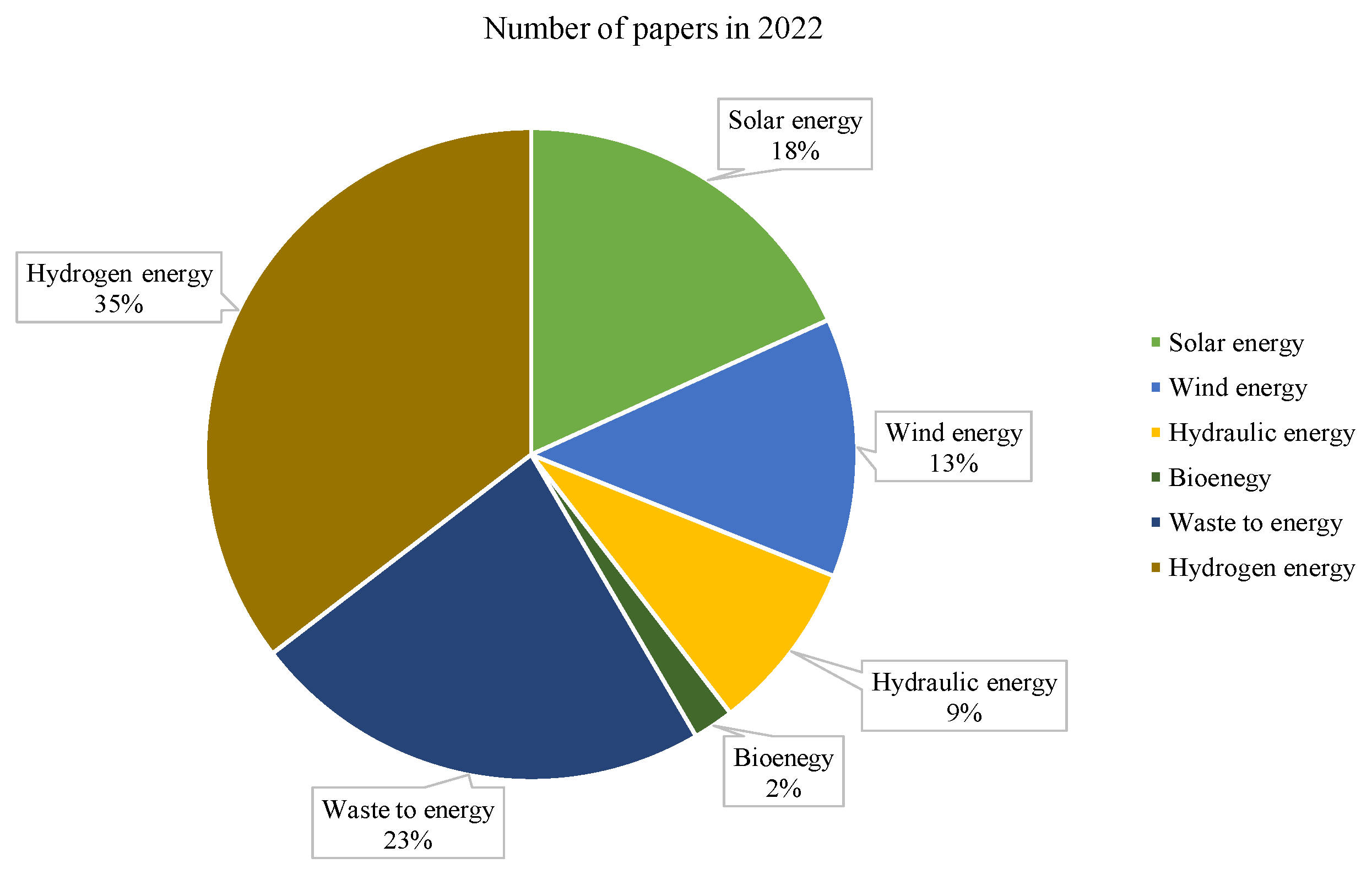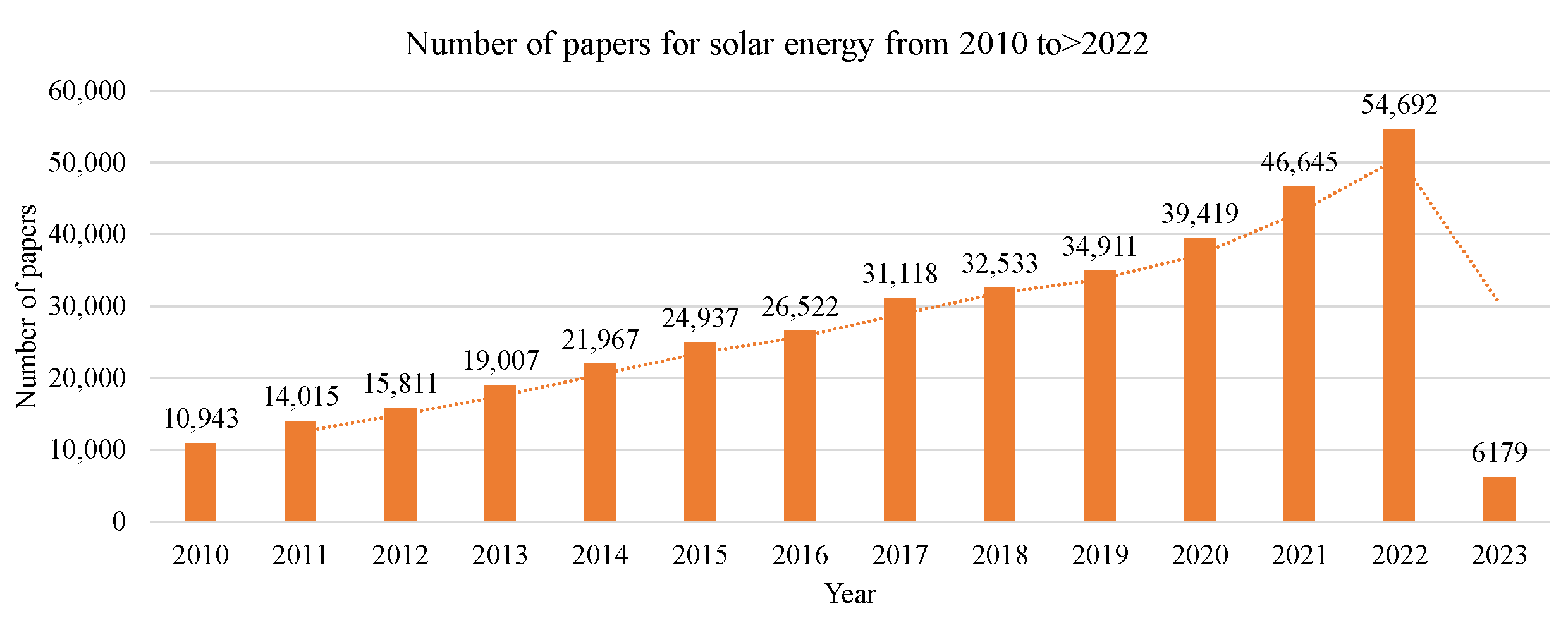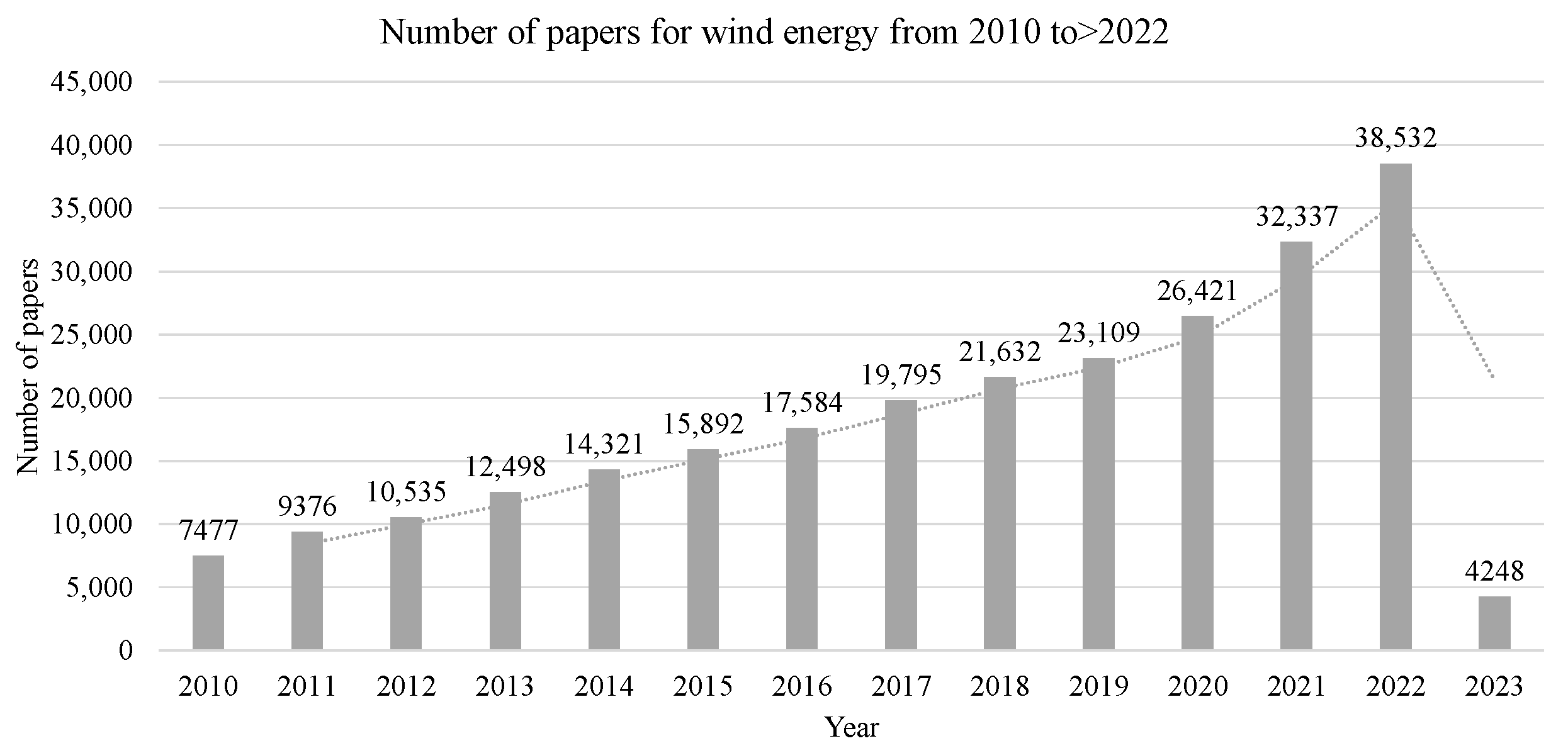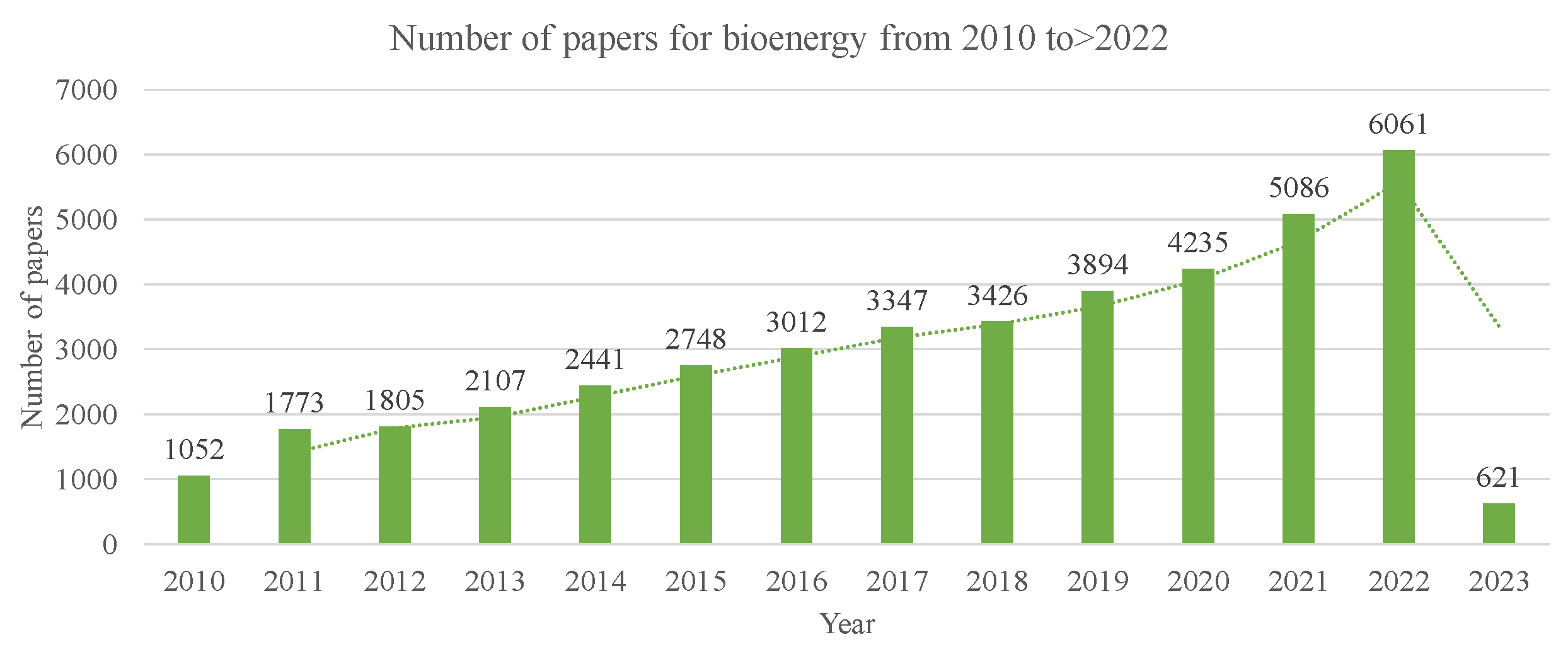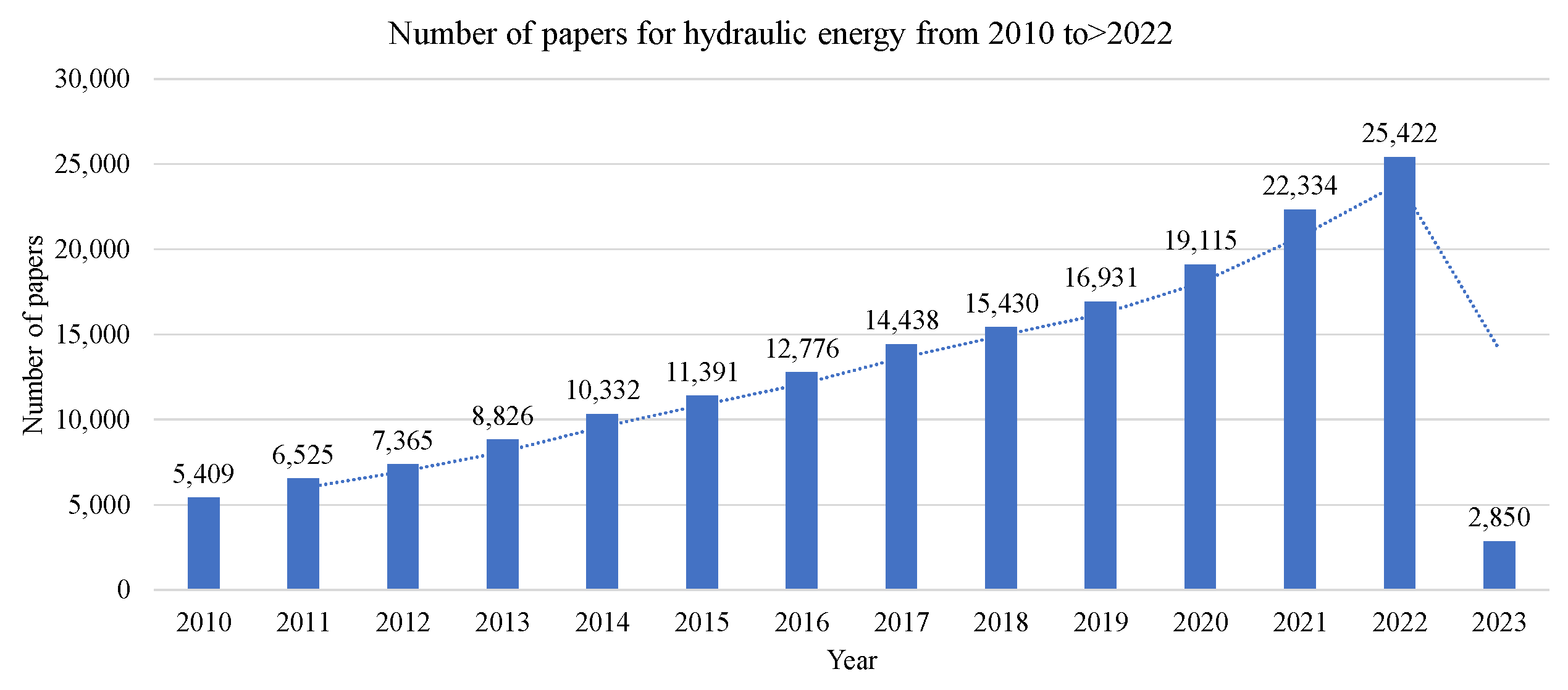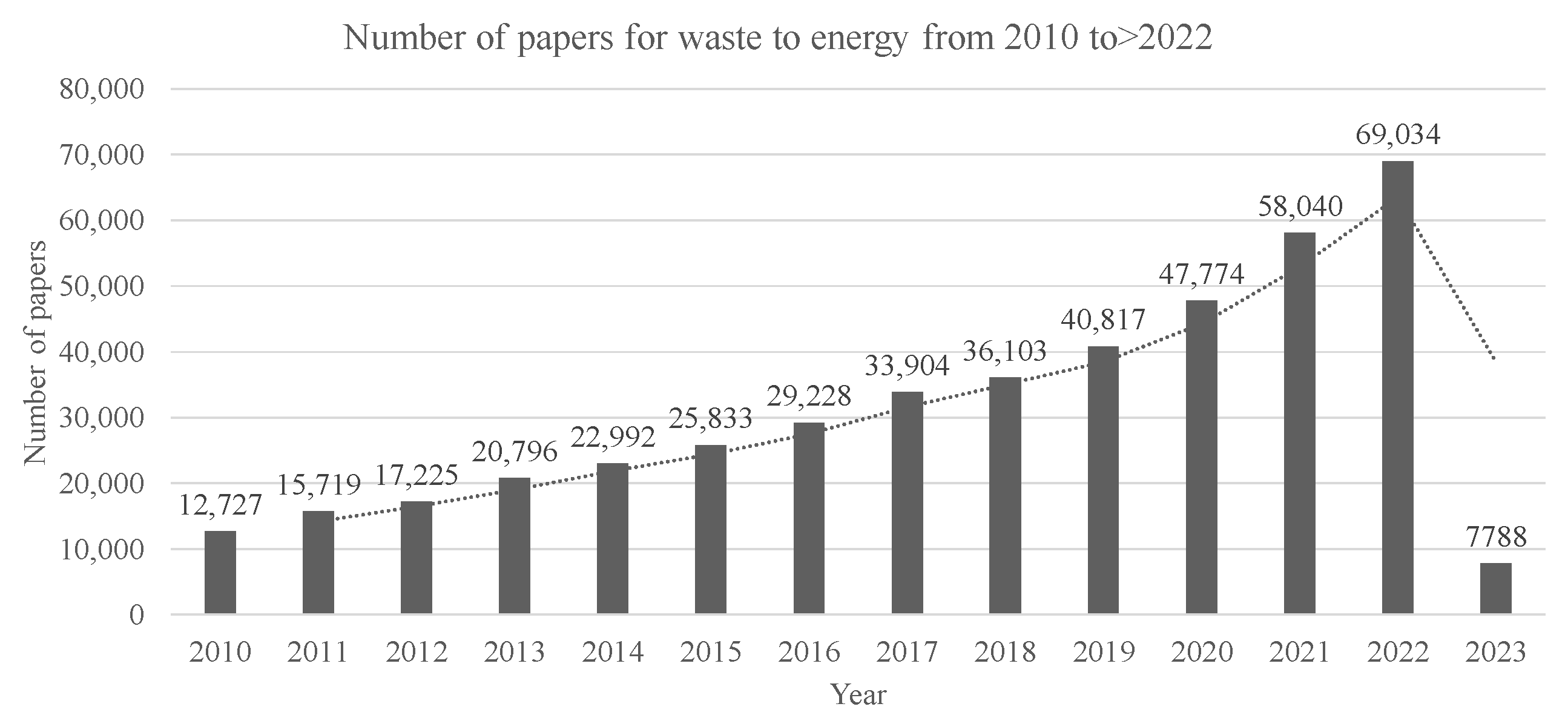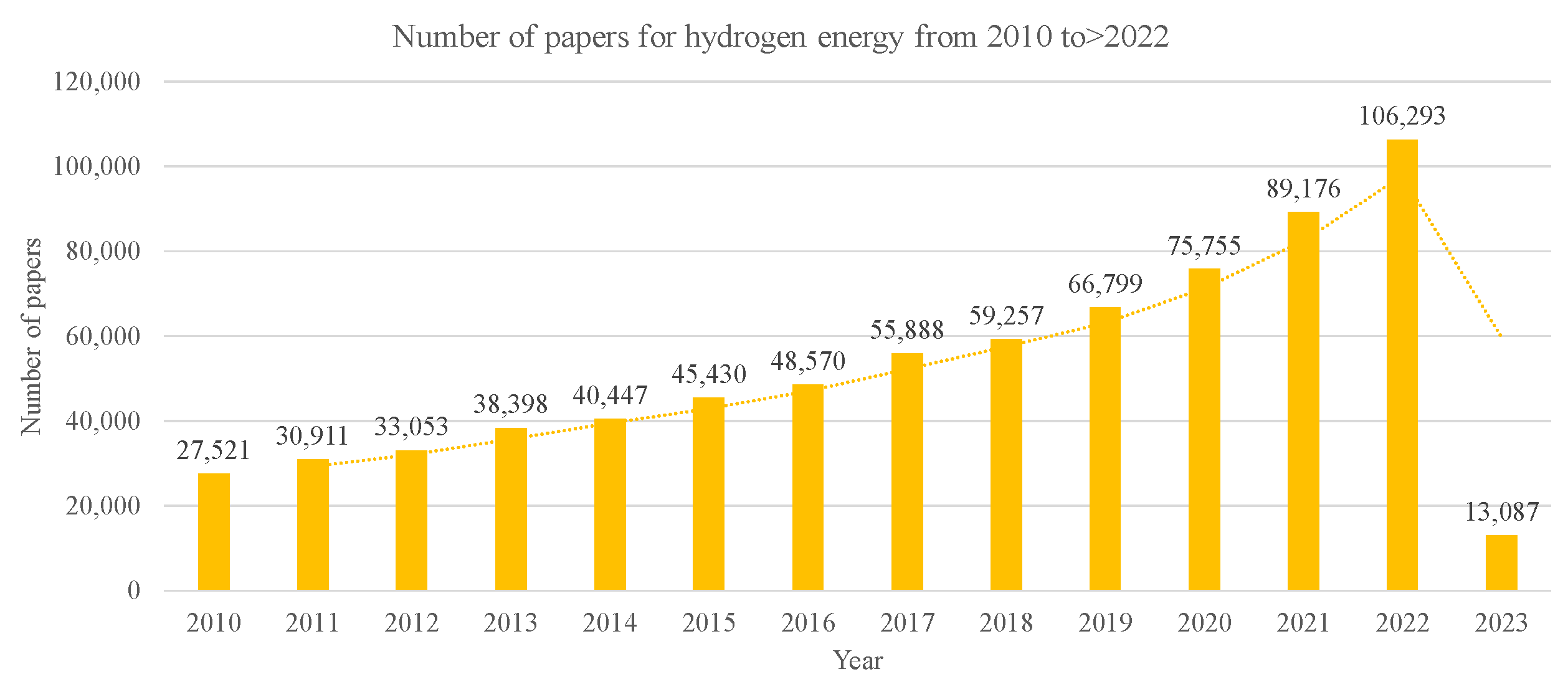2. Renewable Energy Resources and Their Usage
Many research articles study RE resources, their benefit, methodologies, and applicability. The following renewable energy resources are discussed as
- Solar energy
- Wind energy
- Bioenergy
- Hydraulic energy
- Waste to energy and Hydrogen energy
Figure 1 shows that hydrogen energy is the most referred area of RE, followed by waste to energy, solar energy, wind energy, hydraulic energy, and bioenergy. Data have been accessed through ScienceDirect
[4].
Table 1 provides contributions of different researches on RE.
Figure 1. Number of published papers in the field of solar, wind, bio, hydraulic, waste, and hydrogen energy in 2022; accessed on 12 December 2022, 1.30 p.m. KST.
Statistics show that electricity demand increases by 3% during the first half of 2022 compare to 2021. The invasion of Russia in Ukraine in February 2022 had a big impact on electricity growth worldwide. In the meantime, RE increases
[5] by 416 terawatt hours, which is more than the increased energy demand. Report
[6] says that 70% of this increased energy demand will be fulfilled by RE, led by solar and wind, followed by hydropower. A senior electricity analyst Wiatros-Motyka
[7] says
[6] in a report that “The growth in wind and solar in the first half of 2022 prevented a 4% increase in fossil generation. This avoided $40 billion in fuel costs and 230 Mt CO
2 in emissions”. A report from World Economic Forum
[5] in October 2022 says, “New wind and solar met 92 percent of electricity demand in China, 81 percent in the U.S., and 23 percent in India”. This statistic is based on data analysis from over 70 nations. The following sections discuss the above RE resources. Each discussion is designed with a few basics of the corresponding RE, their academic contributions, practical implementations, and limitations.
Table 1. Contribution of different authors.
2.1. Solar Energy
The use of solar energy is not new in mankind. It starts with a magnifying glass in the 7th century B.C., whereas NASA used the first photovoltaic-based spacecraft in 1964
[42]. The development is in the experimental stage anymore; rather, it meets energy demands in daily life. In 2012, solar energy capacity was 100 GW, whereas the growth suppresses 1 TW (1 TW = 1000 GW) in 2022
[43]. This growth is almost doubled in the last three years, since 2018, and it is predicted to reach 2.3 TW by 2025
[44].
Graph (
Figure 2) shows that trends in research on solar energy increase over the year. Until 2020, the moving average curve was flattened and steady. The graph got a hike since 2021 in a different area of application. Abdelrazik et al.
[45] discussed the potential of adopting solar energy in Africa. They explained that Africa is a great source of photovoltaic power from the sun but faces a lot of challenges for RE due to financial, human, and technological resources. Hao et al.
[46] analyzed the performance of solar power systems for heating, cooling, and power storage system with a combination of sunbeam splitting. Similarly, a thermochemical reactor used the biomimetic bone porous structure (Shi et al.
[47]) to improve solar energy conversion. They proved that this method helped to maintain the flow between energy and energy flow within the reactor. That process improved 2.17% solar energy storage efficiency and 8.97% methane conversion.
Figure 2. Development of research in the field of solar energy (2010–2022). The dotted line represents the moving average of the published paper. (>2022 represents continuing 2022).
Mannepalli et al.
[48] developed an article to store excess solar energy using a battery energy storage system (BESS). They optimized the deployment of BESS with a multiobjective constraint optimization. Lei et al.
[49] developed an interesting study that used solar energy for recycling the water vapor evaporated from the coal power station. They found solar energy increased the boiler’s thermal efficiency by 94.44% for the process of heating the feedwater point. Balachandran and Swaminathan
[50] provided insights on indoor cooking by utilizing solar power. They claimed that a solar cooker with technical features helps faster cooking by transferring quick solar energy. Abdullah-Al-Mahbub et al.
[51] proposed that solar energy can solve the electricity problems in the rural area of Bangladesh. Solar energy is a dominant RE in Bangladesh, with 532.5 MW. There are plenty of studies, particularly on solar energy and energy supply chain management (ESCM). Still, the question is how the other research fields can use the concept of solar energy.
Not only in academic research, but development, in reality, is also more attractive. China keeps the lead on using solar power and has become the largest solar energy market in both thermal energy and photovoltaics. They use solar energy for satellite panels, heating processes, and many others
[52][53]. China has built its solar value chain with both huge production and consumption. The top progressive counties in solar energy are China, U.S., Japan, India, Germany, Italy, U.K., France, Australia, and Pakistan. Japan has the world’s largest solar park having a capacity of 63.2 GW, whereas as a developing country, solar energy is used for heating and water purification
[54]. Applications of solar energy, in reality, are so interesting and tech-based. Maldives uses floating solar panels in resorts to provide electricity for tourists. The Netherlands has an almost 70,000 km bike road covered with glasses (photovoltaic cells) to generate energy. U.S. uses solar energy-based carports that can recharge parked cars
[55].
Even less effective, but there are a few problems with using full-capacitor solar energy. First is the gloomy weather. Less sunlight, winter, or rainy seasons presents difficulties for a fully solar energy-operated facility. However, this is a temporary problem for countries with high exposure to sunlight. An energy storage facility can solve this problem. Solar energy can be stored in a storage facility like a battery. Countries with less sunlight can use energy-sharing policies from other countries. Second is the space for the solar facility. A solar setup is expensive and requires a certain space. Changing places is not a flexible economic option for solar energy.
2.2. Wind Energy
The growth of wind energy is gradually increasing every year, and corresponding research articles are growing as well (
Figure 3). The history of using wind energy is very old (maybe B.C.), but commercial use started around the 11th century. People began to use windmills for food production in the Middle East. Around the 1800s, Dutch and U.S. people used small wind turbines for farms and cattle ranches
[56]. Wind power production reached 31,000 MW around the 2000s
[57]. Two types of wind energy are in progress: one is land-based wind energy, and the other one is offshore wind energy. Land-based wind energy projects are built on land. 99% of wind energy projects are based on private lands
[58]. In comparison, offshore wind energy projects are built in water (generally seawater). It has fewer conflicts than onshore wind projects due to land issues.
Figure 3. Research paper publication trends in wind energy (2010–2022). The dotted line represents the moving average of the published paper.
Research finds several issues related to wind energy and provides tentative solutions for those problems. Frantál et al.
[59] discussed land issues associated with increasing wind energy. They compared the Czech Republic and Spain and found that most conflicts happened because of local civic protest, resident-municipality opposition, and interfering neighbor administration. Based on interviews and information, they suggested that more power to municipalities can solve the land issue conflicts faster. Hu et al.
[60] represented an interesting study on convective wind energy from the multi-lane highway. They established that the efficiency of wind energy capture devices (WECD) from the highway is 28.2% under certain conditions. This wind energy was generated by vehicles. A case study from South Korea (Lee et al.
[61]) showed that general people support offshore wind projects more than land-based projects. Based on the survey, they found that people’s willingness to pay (WTP) per household ($3.1 per month) for the offshore project could be beneficial for $744.3 million per year. The authors suggested that the government should improve the public connection for more information about offshore wind projects, and projects should be built by paying tax. Not only these, but also research studies of device development for low-speed wind Younis et al.
[62] and optimal wind energy distribution using reinforcement learning (RL) are going on for wind energy. The distribution of wind energy networking was studied by Zhu et al.
[63], and they proposed an RL for wind energy networking. Shortcomings found in this present research are the lack of a combination of two or more research fields. For example, how can an inventory management sector use wind energy to maximize their profit, or if the inventory manager uses wind power, how much it costs for the system?
Wind energy is one of the fastest-growing renewable energy resources. It grows from 0.5 TW in 2000 to 27.4 TW in 2021 and estimates to install 353 MW capacity in 2022 for wind energy
[64][65]. Costs of offshore wind energy are incredibly higher than onshore firms, but costs have been reduced over the years. Wind energy is mainly used for producing electricity. China is the leading position for onshore wind energy production, followed by the U.S. for offshore wind energy, Germany for onshore wind energy, India has a capacity of almost 40,8000 MW, and Spain
[66]. However, there are a few obstacles to wind energy. One of them is the uncertainty of wind power, which divides wind energy into two parts offshore and onshore. Offshore wind energy solves many shortcomings of wind energy, like wind speed, on-site space problems, and aesthetic impact on people. Meanwhile, the uncertain weather of the sea questions the safety of the offshore wind energy plant. Increasing average temperature causes the increment of sea level, which is a big threat to offshore wind energy plants.
2.3. Bioenergy
Bioenergy is one of the promising renewable energies
[67], which is produced from biomass (
Figure 4). 55% of the total RE comes from bioenergy. Different kinds of bioenergies are biofuel (first, second, third, and fourth generation), biodiesel, and biopower. First-generation biofuel is made from edible biomass. However, it starts to affect the food supply chain worldwide. Then the second-generation biofuel starts to make from nonedible biomass. Still, it affects the wildlife food chain. The third-generation biofuel is made from algae. The third-generation biofuel is more dense, low-cost, and highly energy-efficient. However, it requires a high source of energy to generate lipids. Thus, the fourth-generation biofuel, whose biomass is modified microalgae, comes into the picture. These algae are highly efficient in absorbing
CO2CO2 and enhance production fuel
[68]. Papilo et al.
[69] gave a review in Indonesia, where palm oil was used for bioenergy. Liu et al.
[70] discussed a relation between ecological footprint and bioenergy and its effect on the economy. They reviewed the connection using the quantile-on-quantile methodology. Liu et al.
[71] explained a prediction on the climate change effect on bioenergy, where the biomass was perennial grass. Few studies are found in bioenergy literature, which is used in other sectors as well.
Figure 4. Development of research in bioenergy (2010–2022). The dotted line represents the moving average of the published paper.
The government’s support for the growth of RE is inevitable. The potential of government policies was discussed by Wang et al.
[72] for bioenergy development. Vu et al.
[73] discussed biofuel exploitation from Euphorbia plants. That study was conducted in Vietnam as those plants are available in Vietnam more in quantity. Sathre and Gustavsson
[74] analyzed the life cycle of heavy trucks for emissions from different RE sources. They found that a combination of carbon capture with bioelectricity has negative carbon emissions. In one study of the biodiesel supply chain, a waste animal fat-based biodiesel supply chain was illustrated by Bhuniya et al.
[75] under an uncertain environment. Singh et al.
[76] found process to reduce e-waste (end-of-life products) from a production system through reverse logistics. Mridha et al.
[77] explained a system failure situation for a multibioenergy supply chain, whereas they discussed the improvement procedure of impure biofuel within a biofuel supply chain in another study
[78]. As advertisement policy is a good opportunity to reach customers, a study by Singh et al.
[79] discussed the policy under transportation disruption for a biodiesel supply chain network.
Sweden has their forest as their resource for bioenergy, as 69% of the land area is forest. The country uses bioenergy for heating for both private and commercial purposes
[65]. Biokerosene is used for biojet for air travel, starting from 2021, and is projected to increase biojet fuel demand up to 7% by 2030. The maximum use of biomass is in the traditional section, that, in rural areas, where biomass is used instead of biogas. These are used for household cooking. The next most active sector for biomass consumption is industry, followed by electricity, heat, building, and agriculture
[80]. Industries, which have combustion engines, use more bioenergy than vehicles. Instead, vehicles rely on batteries and electric motors. This is because bioenergy does not have as much capacity as fossil fuel. Moreover, first- and second-generation biofuels are not much ecofriendly due to biomass. Those biomasses have a direct effect on the food supply chain and biodiversity. This problem is solved partially by third- and fourth-generation biofuels.
2.4. Hydraulic Energy
Hydraulic energy is a RE where the force of water is used to make the energy. It is mostly used to produce electric energy from the kinetic energy of water.
Figure 5 shows the research paper publication for hydraulic energy. The graph is increasing, but it is steady growth. The Spread of RE usage depends on the activity of people as well. Available information about RE in a public forum is important for that. Detailed available information will make society understand the benefit of RE over traditional fuels. This aspect was discussed by Meirinhos et al.
[81] for the city of Angolan, Central Africa. The city was excessively dependent on oil and caused too much emissions. That study found that hydraulic and biofuel are the two most promising RE. The tidal force is another significant resource of hydraulic energy. Yin et al.
[82] designed a turbine
H∞ that could increase the tidal energy conversion. Their case study analysis using linear matrix inequality (LMI) showed that the energy efficiency of the proposed turbine was up to 40%.
Figure 5. Development of research in the field of hydraulic energy (2010–2022). The dotted line represents the moving average of the published paper.
Hočevar et al.
[83] explained a long history of hydropower in Slovenia. Slovenia successfully maintained underwater life priority amid the hydroelectric power in the Sava river. That study predicted a need for hydro energy storage by 2027 due to the high demand for energy by 2030. Hydropower is generated from hydraulic turbines, which implies the quality of the turbine and its capacity affect the energy production. However, hydro energy production depends on the quality of the turbines. Caricimi et al.
[84] explained sixteen factors related to a turbine for consideration when selecting turbines. These qualities consisted performance of the turbine, equipment costs, and generator costs. They used AHP and fuzzy algorithms to determine turbines to support small companies. Safety issue for the hydraulic power plant was studied by Bütüner et al.
[85]. They used machine learning to predict safety and predicted 96.45% success with a standard deviation < 1%.
A lot of counties use hydraulic energy for generating energy. Sweden is the first among them who uses hydropower for generating electricity. Sweden establishes a support system “Electricity Certificate System” for electricity production. That support system ensures that the energy sources must come from renewable resources like air, tide, geothermal, etc. 43% electricity comes from hydraulic energy
[65]. Chi et al.
[86] proposed a novel approach of using rooftop rainwater for indoor air ventilation. They claimed that the ventilation device could have 46% energy saving potential of the corresponding building. Another work was proposed by Iyer et al.
[87] that described the use of hydraulic power for room heating purposes. They showed that the mass balance loss could be saved for the direct conversion of wind energy to heat energy. They verified that this medium will be fruitful for windy places and could replace electricity issues. Hydraulic energy plant situates near reservoirs, which is generally not near to locality. As natural water sources are not suitable for producing energy, artificial water reservoirs are mandatory for hydraulic energy plants to store a huge amount of water. The number of efficient reservoirs is less, and building these reservoirs is expensive. Moreover, this whole process affects the water life, especially fish mitigation. A big threat to the hydraulic energy plant is drought. Intense climate change causes less rainfall and increases drought situations in several countries. 2022 hits a record high for extreme temperature, lower rainfall, and highest heat waves. This situation affects the water level of reservoirs and other local water resources.
2.5. Waste to Energy and Hydrogen Energy
Waste to energy conversion reduces waste as well as produces energy. Without increasing waste and pollution, waste is used as a promising RE source. There are a lot of different types of waste as food waste, solid waste, municipal waste, and organic waste
[88]. Conversion equivalency between waste and fossil fuel sources can be represented as: 1 t oil ≃ 4 t wastes and 1 t coal ≃ 2 t wastes
[89]. Waste to energy conversion has a huge impact on waste management as well as a circular economy. The reason for the impact on circular economy is that the circular economy transfers waste to a new product and waste to energy does the same by converting waste mass balance to energy. Generally, heat or/and electricity are produced from wastes.
Figure 6 shows a steady graph for the research in the area of waste to energy.
Figure 6. Development of research in waste to energy (2010–2022). The dotted line represents the moving average of the published paper.
Misganaw et al.
[21] explained a waste to energy scenario from Ethiopia. The country has a huge difference between energy demand and energy production. Waste was detected as a suitable RE resource for Ethiopia, and mass burning had a huge effect. They proved that municipal waste mass burning with recycling facilities produced less energy than just mass burning; the difference is almost 6%. That implied that if recyclable wastes were discarded from waste and used for energy production, that produced nearly 6% less energy than consideration of all waste as energy sources. Caferra et al.
[90] surveyed public opinion on the waste to energy program, their participation in this program, and a few other questions. They found that waste to energy plants could be a good substitute for land-filling and burning wastes. However, still, there was a lack of infrastructure, technology, and a well-designed waste management policy. Yadav et al.
[91] discussed waste reduction from byproducts of a production system. Their pollution reduction policy reduced 25.5% more pollution than other policies.
Biowaste (biomass) has a huge influence on the circular economy. A study found that
[92] artificial neural network (ANN) provided higher heating value (HHV) from biomass. The application of wind energy is not as vast as solar energy. Studies showed that the location of waste in energy plants is an important factor to consider. Silva et al.
[93] explained the most influencing factors as social, legal, environmental, and transportation facility. Local factors, locality (rural or urban) and intention of people of that area had too much influence. Any legal problems for land use and authority issues with local people were other big problems for an energy plant. The facility of water supply and transportation were two other factors in choosing a location for waste to energy plants. There is more than 2179 number of waste to energy plant throughout the globe. In Sweden, only 1% of the total waste are used for landfill, 47% of the total waste is used for recycling, and the rest, 52%, waste are used for producing energy. The country uses this waste for energy for home heating purposes, whereas the U.K. only recycles 44% of the total waste
[94]. In contrast, the main drawback of waste to energy is a proper separation method of mixed waste, especially municipal waste. Municipal waste is one of the sources of waste raw materials for waste to energy plants. The incineration of these wastes causes huge carbon emissions in comparison with the relative energy produced from that corresponding incineration. This incineration process, sometimes called a ‘mass burn,’ destroys recoverable resources. Another new trend is going on for international waste trade. Developed countries send their waste to developing countries.
Hydrogen energy is the most-researched RE in the literature of RE.
Figure 7 shows an increasing graph of hydrogen energy, and this growth becomes higher after 2019. Government subsidy
[17] is the secure option for money flow to avoid loss. They suggested a few criteria to optimize a policy, like product quality increase and execution of hustle-free transportation. But the extraction of hydrogen is a costly process. This makes hydrogen energy expensive and requires a huge amount of investment. Besides, hydrogen is volatile in nature. It is both light in weight and inflammable. Hydrogen can be stored in liquid form. Thus, the hydrogen storage process is more complex than any fossil fuel. The transport of hydrogen energy is difficult due to the complex storage regulations and procedures.
Figure 7. Development of research in the field of hydrogen energy (2010–2022). The dotted line represents the moving average of the published paper.

